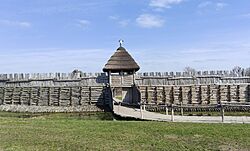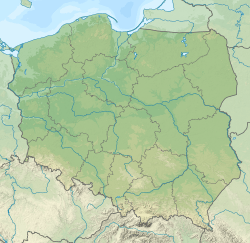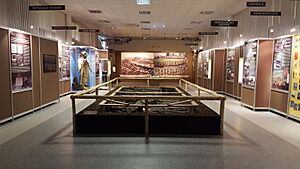Biskupin facts for kids

Reconstructed gateway at Biskupin
|
|
| Location | Biskupin, Kuyavian-Pomeranian Voivodeship, Poland |
|---|---|
| Coordinates | 52°47′18″N 17°44′40″E / 52.78833°N 17.74444°E |
| Type | Settlement |
| History | |
| Material | Wood |
| Founded | c.747–748 BC |
| Site notes | |
| Condition | In ruins, partially reconstructed |
|
Invalid designation
|
|
| Designated | 1994-09-08 |
| Reference no. | M.P. z 1994 r. Nr 50, poz. 412 |
Biskupin is an amazing archaeological site in north-central Poland. It features a life-size model of an ancient village from the late Bronze Age. This special place also works as an archaeological open-air museum, where you can see how people lived long ago.
When Biskupin was first found, people thought it was an early West Slavic settlement. But later, archaeologists learned it belonged to the Lusatian culture. This culture existed around the 8th century BC.
The museum is located on a marshy piece of land that sticks out into Lake Biskupin. This is about 90 kilometers northeast of Poznań. It is also 8 kilometers south of the small town of Żnin. Biskupin became an independent museum in 1998.
This site is so important that it is one of Poland's official national Historic Monuments. It received this special title on September 16, 1994.
Contents
Discovering Ancient Biskupin
In 1933, a schoolteacher named Walenty Szwajcer and his students made an exciting discovery. They found the remains of an old fort or village from the Bronze Age. This was in the Wielkopolska Region, also known as Greater Poland. The news of their find quickly spread everywhere!
Archaeologists from Poznań University started digging at the site in 1934. Józef Kostrzewski and Zdzisław Rajewski led these important excavations. By 1939, they had uncovered a large area of the ancient settlement.
Biskupin quickly became very famous in Poland. Many important people visited, including government officials and church leaders. It became a symbol of the achievements of ancient Polish people. People even called it the "Polish Pompeii" or "Polish Herculaneum". The discovery showed that people in this area had strong settlements thousands of years ago.
When Germany took over Poland in 1939, they renamed Biskupin "Urstädt." German archaeologists continued digging there until 1942. When they had to leave, they flooded the site. They hoped to destroy it, but this actually helped! The water kept the ancient wooden structures very well preserved. Polish archaeologists returned after the war and continued their work until 1974.
Life in the Ancient Biskupin Settlement
Biskupin had two main periods of settlement, one right after the other. Both villages were built on a rectangular grid, like a city block plan. They had eleven streets, each about 3 meters wide.
The older village was built on a slightly wet island that was over 2 hectares in size. It had about 102 to 106 houses made of oak and pine logs. All the houses looked very similar. Each house was about 8 by 10 meters and had two rooms. There was also an open area at the entrance.
These houses were designed to hold 10 to 12 people. In the middle of the biggest room, there was an open fireplace for cooking and warmth. There were no bigger houses, which suggests that everyone in the village lived in a similar way. Because the ground was wet and boggy, the streets were covered with wooden planks.
The entire settlement was protected by a tall wooden wall, called a palisade. This wall sat on a rampart, which was a mound made of wood and earth. The rampart was built using oak tree trunks filled with earth. It was more than 450 meters long. A wooden breakwater in the lake also helped protect the village. Building these defenses used a huge amount of wood, between 6,000 and 8,000 cubic meters!
Biskupin in Popular Culture
The Biskupin archaeological site has appeared in many interesting ways.
- It was featured on stamps issued by the Polish Post in 1966 and 1978.
- The settlement was used as a filming location for several movies. These include Jerzy Hoffman's 1998 historical drama With Fire and Sword. It also appeared in the 2003 historical film An Ancient Tale: When the Sun Was a God.
- In August 2018, Biskupin was celebrated with a Google doodle. This was to mark the 85th anniversary of the site's discovery.
Dating the Ancient Village
The settlement at Biskupin belongs to the Hallstatt culture periods C and D. These periods are part of the late Bronze Age and early Iron Age. They date from about 800–650 BC and 650–475 BC.
Scientists used a method called radiocarbon dating to find out how old the site was. However, a more accurate method called dendrochronology gave even better results. Dendrochronology studies the growth rings in trees. By looking at the rings in the oak wood used to build Biskupin, scientists could tell exactly when the trees were cut down.
This tree-ring analysis showed that the oak wood was cut between 747 and 722 BC. More than half of the wood used was cut during the winter of 748/747 BC. This gives us a very precise date for when the ancient village was built!
The Reconstructed Model
In 1936, the first life-size model of the settlement was built on the peninsula. This was like an open-air museum. Sadly, this model was destroyed on purpose by German forces near the end of World War II.
After the war, the model was rebuilt. The strong ramparts and one full street with houses on both sides were also added. This allows visitors to imagine what life was like in ancient Biskupin.
In the 2000s, a film prop that looked like a "medieval" timber castle was built on part of the original site.
Gallery
See Also
- Castles in Poland
- Archeology
- Bronze Age
- Kuyavian-Pomeranian Voivodship
- Lusatian culture
- Pałuki
- Wenecja, Kuyavian-Pomeranian Voivodeship
- Żnin
- Gąsawa










